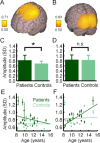Resting-state oscillatory dynamics in sensorimotor cortex in benign epilepsy with centro-temporal spikes and typical brain development
- PMID: 26177579
- PMCID: PMC6869151
- DOI: 10.1002/hbm.22888
Resting-state oscillatory dynamics in sensorimotor cortex in benign epilepsy with centro-temporal spikes and typical brain development
Abstract
Benign Epilepsy with Centro-Temporal Spikes (BECTS) is a common childhood epilepsy associated with deficits in several neurocognitive domains. Neurophysiological studies in BECTS often focus on centro-temporal spikes, but these correlate poorly with morphology and cognitive impairments. To better understand the neural profile of BECTS, we studied background brain oscillations, thought to be integrally involved in neural network communication, in sensorimotor areas. We used independent component analysis of temporally correlated sources on magnetoencephalography recordings to assess sensorimotor resting-state network activity in BECTS patients and typically developing controls. We also investigated the variability of oscillatory characteristics within focal primary motor cortex (M1), localized with a separate finger abduction task. We hypothesized that background oscillations would differ between patients and controls in the sensorimotor network but not elsewhere, especially in the beta band (13-30 Hz) because of its role in network communication and motor processing. The results support our hypothesis: in the sensorimotor network, patients had a greater variability in oscillatory amplitude compared to controls, whereas there was no difference in the visual network. Network measures did not correlate with age. The coefficient of variation of resting M1 peak frequency correlated negatively with age in the beta band only, and was greater than average for a number of patients. Our results point toward a "disorganized" functional sensorimotor network in BECTS, supporting a neurodevelopmental delay in sensorimotor cortex. Our findings further suggest that investigating the variability of oscillatory peak frequency may be a useful tool to investigate deficits of disorganization in neurodevelopmental disorders.
Keywords: benign epilepsy with centro-temporal spikes; beta-band oscillations; magnetoencephalography; resting-state networks; sensorimotor cortex.
© 2015 Wiley Periodicals, Inc.
Figures




Similar articles
-
Ipsilateral cortical motor desynchronisation is reduced in Benign Epilepsy with Centro-Temporal Spikes.Clin Neurophysiol. 2016 Feb;127(2):1147-1156. doi: 10.1016/j.clinph.2015.08.020. Epub 2015 Oct 14. Clin Neurophysiol. 2016. PMID: 26522940
-
Beta oscillations in the sensorimotor cortex correlate with disease and remission in benign epilepsy with centrotemporal spikes.Brain Behav. 2019 Mar;9(3):e01237. doi: 10.1002/brb3.1237. Epub 2019 Feb 20. Brain Behav. 2019. PMID: 30790472 Free PMC article.
-
Evidence for a neurophysiologic auditory deficit in children with benign epilepsy with centro-temporal spikes.J Neural Transm (Vienna). 2006 Jul;113(7):939-49. doi: 10.1007/s00702-005-0357-6. Epub 2005 Oct 27. J Neural Transm (Vienna). 2006. PMID: 16252074
-
[Cognitive deficits are underestimated in children with benign epilepsy with centro-temporal spikes].Ugeskr Laeger. 2016 Nov 7;178(45):V04160249. Ugeskr Laeger. 2016. PMID: 27855768 Review. Danish.
-
Physiological and pathological oscillatory networks in the human motor system.J Physiol Paris. 2006 Jan;99(1):3-7. doi: 10.1016/j.jphysparis.2005.06.010. Epub 2005 Jul 27. J Physiol Paris. 2006. PMID: 16054347 Review.
Cited by
-
Altered Language-Related Effective Connectivity in Patients with Benign Childhood Epilepsy with Centrotemporal Spikes.Life (Basel). 2023 Feb 20;13(2):590. doi: 10.3390/life13020590. Life (Basel). 2023. PMID: 36836947 Free PMC article.
-
Effects of altered excitation-inhibition imbalance by repetitive transcranial magnetic stimulation for self-limited epilepsy with centrotemporal spikes.Front Neurol. 2023 May 26;14:1164082. doi: 10.3389/fneur.2023.1164082. eCollection 2023. Front Neurol. 2023. PMID: 37305755 Free PMC article.
-
Brain Punch: K-1 Fights Affect Brain Wave Activity in Professional Kickboxers.Sports Med. 2024 Dec;54(12):3169-3179. doi: 10.1007/s40279-024-02082-5. Epub 2024 Aug 7. Sports Med. 2024. PMID: 39112919 Free PMC article.
-
Sensorimotor control: computing the immediate future from the delayed present.BMC Bioinformatics. 2016 Jul 25;17 Suppl 7(Suppl 7):245. doi: 10.1186/s12859-016-1098-2. BMC Bioinformatics. 2016. PMID: 27454449 Free PMC article.
-
Alzheimer's disease disrupts alpha and beta-band resting-state oscillatory network connectivity.Clin Neurophysiol. 2017 Nov;128(11):2347-2357. doi: 10.1016/j.clinph.2017.04.018. Epub 2017 May 8. Clin Neurophysiol. 2017. PMID: 28571910 Free PMC article.
References
-
- Archer JS, Briellman RS, Abbott DF, Syngeniotis A, Wellard RM, Jackson GD (2003): Benign Epilepsy with centro‐temporal spikes: Spike Triggered fMRI shows somato‐sensory cortex activity. Epilepsia 44:200–204. - PubMed
-
- Barnett A, Henderson SE, Scheib B, Schulz C ( 2007): The Detailed Assessment of Speed of Handwriting. London: Pearson.
-
- Besenyei M, Varga E, Fekete I, Puskás S, Hollódy K, Fogarasi A, Emri M, Opposits G, Kis SA, Clemens B (2012): EEG background activity is abnormal in the temporal and inferior parietal cortex in benign rolandic epilepsy of childhood: A LORETA study. Epilepsy Res 98:44–49. - PubMed
-
- Besseling RMH, Overvliet GM, Jansen JFA, van der Kruijs SJM, Vles JSH, Ebus SCM, Hofman PAM, de Louw AJA, Aldenkamp AP, Backes WH (2013b): Aberrant functional connectivity between motor and language networks in rolandic epilepsy. Epilepsy Res 107:253–262. - PubMed
Publication types
MeSH terms
Grants and funding
LinkOut - more resources
Full Text Sources
Other Literature Sources

